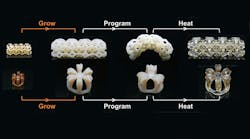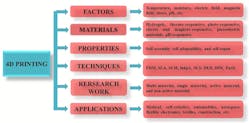Gutenberg’s printing press revolutionized the way the written word was replicated, bringing two-dimensional printing into the world and so vastly increasing accessibility of information. From that first printing press to today’s inkjet and laser jet technologies, printing has become an indispensable part of our day-to-day functionality as a society. And just when we’d become accustomed to those parameters—and definitions—of printing, another dimension emerged.
Centuries post-Gutenberg, Messrs. Hull and Crump changed the game, adding a third dimension to printing capabilities. Their inventions, stereolithography (SLA) and fused deposition modeling (FDM), respectively, introduced three-dimensional printing. Now familiar as “3D printing,” these processes add material layer by layer to create a full physical object, effectively printing something into being.
Given the pace of human innovation, it’s no surprise it took decades, not centuries, to add the next dimension to the advanced manufacturing lexicon. 4D printing incorporates another dimension: time.
Time seems more an idea than a physical dimension, however much “Doctor Who” we watch. When it comes to plotting it, time isn’t nearly so concrete an axis as width, height or length.
So what is 4D printing? When would it be relevant beyond an R&D lab? What hardware, software and materials does it need for success? Let’s demystify.
The Dimensions of Additive Manufacturing
The advanced manufacturing discipline incorporating material added to—rather than, as is traditional, subtracted from or molded into—a build is known collectively as additive manufacturing (AM). 3D printing is one part of this workflow, bookended by pre- and post-processing (e.g., design for additive manufacturing, or DfAM; support removal; polishing or painting; etc.).
The AM workflow also increasingly incorporates another additive build process through the still-nascent discipline of 4D printing.
READ MORE: 4D Printing: A Revolution Across Industries
Length, width, height and an additional dimension are precisely designed, programmed into and built up in the course of 4D printing. To best understand what this is and how it differs from its more familiar predecessor, it helps to define each of these additive technologies.
3D Printing
The term “3D printing” is an umbrella reference for the seven ASTM-recognized technologies. In addition to the aforementioned SLA and FDM processes, the additional means of 3D printing include:
- Deposited energy deposition (DED)
- Powder bed fusion (PBF)
- Material jetting
- Binder jetting
- Sheet lamination
Each of these broad categories has several inclusions. For example, under ASTM’s definitions, SLA is included in the “vat photopolymerization” bucket, and FDM (and its non-trademarked equivalent of fused filament fabrication, or FFF) is considered a “material extrusion” technology. Further, the PBF category is fleshed out with processes including direct metal laser sintering (DMLS), electron beam melting (EBM), selective heat sintering (SHS), selective laser melting (SLM) and selective laser sintering (SLS).
Seemingly endless R&D continues to introduce new processes that the ASTM F42–Additive Manufacturing considers for appropriate placement of definition in these categories, or perhaps into their own new category.
4D Printing
A wholly new category that can’t fit into those defined buckets, 4D printing is, in the immortal words of David S. Pumpkins, “its own thing.”
While building on the foundations of its AM predecessors—literally—4D printing transforms over time, by design, from the part that emerges from the printer.
The dimension of “time” is loosely defined, as over time different elements may trigger transformation. Heat, light, moisture, magnets, physical stresses or other elemental changes cause a structural shift in the printed part, changing its form and format in response to the differing conditions.
The Animorphs of the AM world, 4D printed objects are designed with transformation in mind. Programmable advanced materials can, for example, unfold, expand, shrink, self-repair, self-assemble, close/open a circuit or otherwise adjust to specific stimuli.
4D Printing: How, When and Why
At first definition, 4D printing presents an intriguing concept. But then the questions begin: How does one design for transformative physical production? What materials, software and hardware are required for this type of advanced manufacturing? When is 4D printing actually helpful for realizable applications? Why is 4D printing breaking free of its R&D lab beginnings to become a commercial reality?
How an Additional Dimension Changes Printing
Because a 4D-printed object is designed to change shape, it adjusts to different environments and/or stimuli in a planned, controlled manner. This flexibility of part requires careful design thinking as well as a clear understanding of fundamental principles like computational folding, shape memory materials and application requirements.
Each step of the manufacturing process must be honed and tuned in for 4D printing to work.
Materials
Given the requirements of adaptability in 4D printing, these processes require the use of smart materials.
The single biggest understanding in the materials space of 4D printing is of shape memory materials. Essentially, these materials “remember” their original shape so they can return to it after having reshaped in response to external conditions.
More technically, a paper from a 2010 publication of Materials Today explains:
“Shape memory materials (SMMs) are featured by the ability to recover their original shape from a significant and seemingly plastic deformation when a particular stimulus is applied. This is known as the shape memory effect (SME). Superelasticity (in alloys) or visco-elasticity (in polymers) are also commonly observed under certain conditions. The SME can be utilized in many fields, from aerospace engineering (e.g., in deployable structures and morphing wings) to medical devices (e.g., in stents and filters).”
Shape memory effects can be found among polymer, metal, ceramic and bio-based materials, enabling applicability in a variety of applications. Their use has more specifically begun to be tuned to AM processes over the last decade, with initial introduction of the conceptual use of 4D printing broadly credited to research from MIT, as presented in a 2013 TED Talk.
A more recent paper, published in Research in November 2023 and focusing on 4D printing applications, begins:
“Shape memory polymers (SMPs) and their composites (SMPCs) are smart materials that can be stably deformed and then return to their original shape under external stimulation, thus having a memory of their shape.”
And continues:
“With addition of time as the fourth dimension, the 4D printing technology allows the fast development of ‘living’ adaptable structures that enables the growth opportunities in various fields.”
READ MORE: Finger to the Wind: MD&M West 2023 Exhibitors Call the Trends
The stable deformation and predictable reformation of these materials is its own science. Developments begun at MIT and continued on throughout the world over the last decade have combined these SMMs with AM processes to create parts that can not only be larger than the print volume of a given 3D printer, but find applicability in a variety of near-term and longer-term applications in conjunction with the appropriate suite of end-to-end equipment.
Of course, other materials—hydrogels, multi-material, liquid crystal elastomers, metals, ceramics and food/edible materials, among others—are constantly in use and development as well as the 4D printing space develops.
Software
For programmable shape-changing capabilities, the part designed must be, plainly, programmed. This brings in the software component of 4D printing to design, simulate and program the object, turning a draft plan into realizable component.
Because the ways in which the final desired part may be manipulated vary—some unfold into larger surface areas, some stiffen or soften, others change color and so on—their programming must be precise.
Computational design, for instance, is the science that enables the production of objects capable of unfolding into geometries larger than a 3D printer to be printed as a single part.
As illustrated in the diagram above, a comprehensive study in the 4D printing of food explains the software stages of the process:
“The effective software solution is an essential factor in 4D printing as it enables the manufacture of the desired product. The 4D model design and printing process involved using a series of software solutions and a management software solution. It includes one solution for each of five stages, such as Simulation, Modeling, Slicer, Host/Firmware, Monitoring and one Printing Management software.”
These five stages are familiar in any type of additive manufacturing and play vital roles in 4D printing in particular. Simulation will allow for the representation of a digital twin of the part to respond to the expected parameters of stimulation, showing before production the expected real-world performance prior to printing.
Hardware
The “magic” of 4D printing lies primarily in the smart materials and specific design programmed into the design. Any AM build, 3D or 4D printable, requires appropriate hardware. The good news, if we will, is that 4D printing is compatible with essentially any 3D printer that can handle the smart materials necessary for a given 4D design.
Material extrusion (FFF, FDM) and vat photopolymerization (SLA, DLP, LCD) 3D printers are those most often used in 4D printing today. The original work behind the coining of “4D printing” as a popularized phrase emerged from MIT, in collaboration with Stratasys and Autodesk, using Stratasys’ FDM 3D printers.
Essentially any 3D printer and 3D printing process can be used for 4D printing.
When 4D Printing is the Answer: Applications
The when and the who of 4D printing compound into an overarching question of applications: When is 4D printing appropriate, and who are the current and future users of this technology?
Target applications for 4D printing will often fall in line with those for 3D printing—going beyond the constraints of three dimensions. It’s hard to imagine anyone turning to 4D without having first familiarized themselves with 3D printing, especially with the clear overlap in terms of software expertise and hardware availability. Education is certainly a barrier to entry in any advanced manufacturing endeavor, and all the more so for one so relatively nascent as 4D printing.
READ MORE: Future-Proofing Manufacturing with 3D Printing
To date, most 4D printing applications remain proofs of concept that may or may not have ever left a lab. Many of those that have are still more fashion than function—think along the lines of runway versus commercial fashion; some things don’t translate to the day-to-day despite a strong showing at Fashion Week.
Among some of the applications for 4D printing gaining traction and interest are:
- Self-repairing/self-assembling items
- Soft robotics
- Flexible electronics
- Sensors
- Smart textiles
- Aerospace
- Bioprinting
- Wound healing
- Food
Specific use cases—think self-assembling furniture and self-repairing plumbing pipes—are further along in development than others. Biomedical applications in particular will require years more testing and, eventually, live human subjects to undergo lengthy studies before 4D printed implants, stents and other medical devices become commonplace. It’s likely that one day they will, but we’ll give that time yet.
Why 4D Printing is on the Rise
As one of the most advanced means of manufacturing today, 4D printing is subject to scrutiny and R&D investment. Its promise is great, its premise proven. With the capability of producing self-changing parts and products, we can only expect to see the rise of 4D printing going forward.
When, how and, overall, if 4D printing leaps out of the R&D lab, though, remains in large part to be seen. Especially translating into commercialization with larger-scale production capabilities, 4D printing has a lengthy runway ahead of it to make the cost/benefit balance viable.
We live in a complicated world. High-tech solutions for today’s problems are in demand, in development and on their way. 4D printing offers the next dimension for advanced manufacturing to address these opportunities.
Sarah Goehrke, founder, Additive Integrity LLC, is a freelance writer and 3D printing industry expert. She is based in Cleveland, Ohio.





